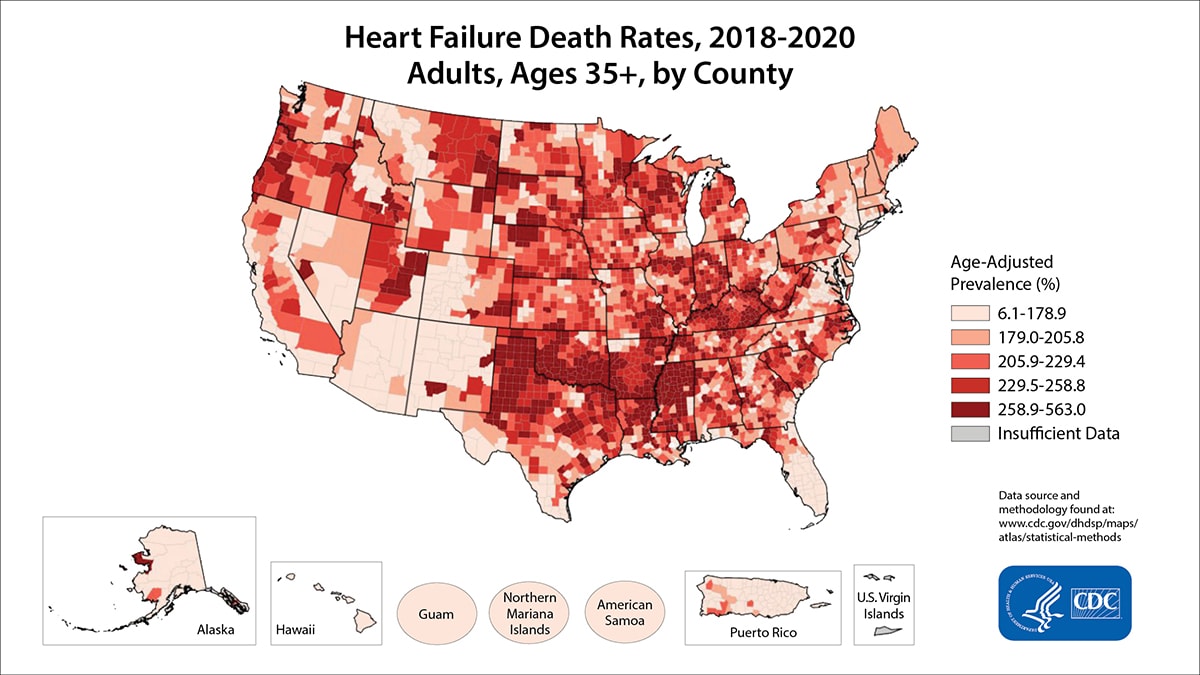Key points
- Heart failure happens when the heart cannot pump enough blood and oxygen to support other organs in your body.
- Certain medical conditions can increase your risk for heart failure.
Overview
Heart failure happens when the heart cannot pump enough blood and oxygen to support other organs in your body. Heart failure is a serious condition, but it does not mean that the heart has stopped beating.
Facts about heart failure in the United States
- In the United States, nearly 6.7 million adults 20 years old or older have heart failure.1
- In 2023, heart failure was mentioned on 452,573 death certificates (and responsible for 14.6% of all causes of death).2
- Heart failure cost the nation an estimated $30.7 billion in 2012. This total includes the cost of health care services, medicines to treat heart failure, and missed days of work.3
Deaths from heart failure vary by geography
Heart failure is more common in some areas of the United States than in others. Below is a map showing the rate of death from heart failure by county.

Symptoms
Common symptoms of heart failure include:
- Shortness of breath during daily activities.
- Trouble breathing when lying down.
- Weight gain with swelling in the feet, legs, ankles, or stomach.
- Generally feeling tired or weak.
Risk factors
Certain medical conditions can increase your risk for heart failure, including:
- Coronary artery disease (CAD) (the most common type of heart disease) and heart attacks.
- Diabetes
- High blood pressure
- Obesity
- Other conditions related to heart disease
- Heart valve disease
Unhealthy behaviors can also increase your risk for heart failure, especially for people who have one of the conditions listed above. Unhealthy behaviors include:
- Smoking tobacco.
- Eating foods high in fat, cholesterol, and sodium (salt).
- Not getting enough physical activity.
- Excessive alcohol intake.
Treatment and recovery
Early diagnosis and treatment can improve quality and length of life for people who have heart failure. Treatment usually involves the following:
- Taking medicines.
- Reducing sodium in the diet.
- Drinking less liquids.
- Using devices that remove excess salt and water from the blood.
- Having heart transplant and other surgeries.
- Getting daily physical activity.
People with heart failure also track their symptoms each day so that they can discuss these symptoms with their health care team.
- Martin SS, Aday AW, Almarzooq ZI, et al.; American Heart Association Council on Epidemiology and Prevention Statistics Committee; Stroke Statistics Subcommittee. 2024 heart disease and stroke statistics: a report of US and global data from the American Heart Association. Circulation. 2024;149:e347–913.
- National Center for Health Statistics. Multiple Cause of Death 2018-2023 on CDC WONDER Database. Accessed February 1, 2025. https://wonder.cdc.gov/mcd.html
- Benjamin EJ, Muntner P, Alonso A, et al. Heart disease and stroke statistics—2019 update: a report from the American Heart Association. Circulation. 2019;139(10):e56–e528.
